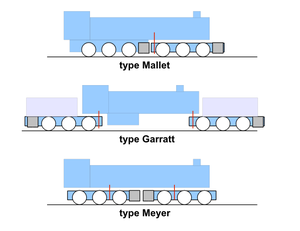
Back Gelenklokomotive German Locomotora articulada Spanish Locomotive articulée French 関節式機関車 Japanese Parowóz wieloczłonowy Polish Locomotiva articulada Portuguese Сочленённый паровоз Russian
This article includes a list of references, related reading, or external links, but its sources remain unclear because it lacks inline citations. (April 2015) |


An articulated locomotive is a steam locomotive (rarely, an electric locomotive) with one or more engine units that can move independently of the main frame. Articulation allows the operation of locomotives that would otherwise be too large to negotiate a railroad's curves, whether mainlines or special lines with extreme curvature such as logging, industrial, or mountain railways.
Articulated locomotives saw service in many nations, but were very popular on narrow-gauge railways in Europe. The largest examples were developed in the United States, where the Union Pacific Big Boy 4-8-8-4s and the Allegheny H-8 2-6-6-6s were some of the largest steam locomotives ever built, with Big Boy 4014 remaining as the largest, and last of its kind to still operate.
Many schemes for articulation were developed over the years. Of these, the Mallet locomotive and its simple-expansion derivative were the most popular, followed by the Garratt type (mostly built in the United Kingdom, popular throughout Europe, Africa and European colonies), and the various geared steam locomotive types, the latter largely used in logging, mining and industry. Most other types saw only limited success.
As distinct from articulated locomotives, a non-articulated locomotive is referred to as a straight or rigid locomotive.
© MMXXIII Rich X Search. We shall prevail. All rights reserved. Rich X Search